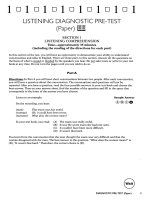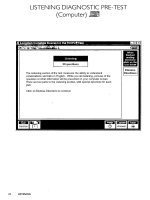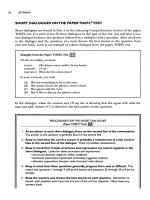complete reflexology for life
Bạn đang xem bản rút gọn của tài liệu. Xem và tải ngay bản đầy đủ của tài liệu tại đây (18.39 MB, 354 trang )
HELP AND HEAL COMMON AILMENTS with
sequences for conditions from asthma and
allergies to high blood pressure and stress
ALL THE TECHNIQUES YOU NEED to help every
family member, from an over-tired toddler to
an elderly person with arthritis
DETAILED SEQUENCES treat specific common
ailments, with quick routines for home, work,
or on the move
THE FIRST FULLY ILLUSTRATED ONE-STOP REFLEXOLOGY
RESOURCE, from Kevin and Barbara Kunz, the world’s
most authoritative reflexology experts
$25.00 USA
$30.00 Canada
Discover more at
www.dk.com
Kevin and Barbara Kunz have been
pioneers in the research, teaching,
practice, regulation, and documentation
of reflexology for over 30 years. They are
bestselling authors and their books are
published in eighteen foreign languages
and in 30 different countries.
Barbara and Kevin are co-directors of
the organization Reflexology Research;
co-editors of the organization’s journal,
Reflexions, now in its 27th year of
publication; and maintain three websites,
which between them have 7–8 million
hits. They travel worldwide, teaching and
giving talks on reflexology. Their books on
reflexology include: Reflexology and Hand
Reflexology, both published by DK. For
more information, visit their website—www.
reflexology-research.com.
In the course of day-to-day life, we all
experience a range of common ailments.
Complete Reflexology for Life can help you
heal everyone, from the tiniest newborn
through to the most senior person. The
wonderfully calming power of touch will also
help you to forge stronger bonds with all the
important people in your life.
Complete Reflexology for Life teaches you how
to incorporate reflexology into your busy daily
routine. Take a few moments out to connect with
all of those in need of the natural healing touch
of reflexology, or to relieve your own stresses
and strains. It also features reflexology for
special situations, showing, for example, how
to take care of feet tired from a day at work.
Discover the following:
• Principles and techniques of reflexology
• Self-help sessions and treatments for every
life stage
• Effective ways to treat health concerns
• Treatments for personal and professional use
complete reflexology for life
Barbara &
Kevin Kunz
The definitive illustrated reference to reflexology
for all ages—from infants to seniors
Barbara & Kevin Kunz
reflexology
complete
for life
“Change your life with
reflexology. Millions have.”
Kevin and Barbara Kunz
reflexology
complete
for life
reflexology
complete
for life
Printed in China
Some material
in this book was
previously published
in Reflexology and
Hand Reflexology.
reflexology
complete
for life
complete
for life
Barbara & Kevin Kunz
Contents
6 You can change your life
with reflexology
8 Introduction
12 The principles of
reflexology
The history of reflexology 14 • How reflexology
works 18 • Reflexology and zones 22 • Reflexology
maps 26 • The skeleton and the foot 34
36 Benefits for life
Showing that you care 38 • The healing touch 40
• Reflexology as a stress-buster 42 • Building
physical awareness 44 • Aiming for healthy aging
46 • Self-help reflexology 48 • Creating natural
solutions 50 • The reflexology lifestyle 52
• Reflexology research 54 • Success stories 56 • Look
after your feet 58 • Look after your hands 62
66 Reflexology techniques
Preparing for a session 68 • Basic techniques 72
• Foot desserts 78 • Complete foot sequence 84
• Complete self-help foot sequence 108 • Hand
desserts 122 • Complete hand sequence 126 • Self-
help hand desserts 142 • Complete self-help hand
sequence 146 • Using self-help foot tools 162
• Using self-help hand tools 168 • Foot relaxation
exercises 178 • Hand relaxation exercises 180
182 Mini-sessions for
getting results
All about mini-sessions 184 • Recovering from
injury 186 • Easing pain 188 • First aid 190 • Health
concerns 192 • Relieving stress 194 • Providing
comfort 198
LONDON, NEW YORK, MELBOURNE, MUNICH, and DELHI
Senior editor Jo Godfrey Wood
Senior art editor Peggy Sadler
Editors Aditi Ray, Andrea Bagg, Diana Vowles
Designer Arunesh Talapatra
US editors Christy Lusiak
Managing editor Penny Warren
Managing art editor Marianne Markham
DTP designer Sonia Charbonnier
Production controller Rebecca Short
Art director Peter Luff
Category publisher Mary-Clare Jerram
Photography by Ruth Jenkinson
Every effort has been made to ensure that the information contained in this book
is complete and accurate. However, neither the publisher nor the authors are
engaged in rendering professional advice or services to the individual reader. The
ideas, procedures, and suggestions contained in this book are not intended as a
substitute for consultation with your healthcare provider. All matters regarding
your health require medical supervision. Neither the publisher nor the author
accept any legal responsibility for any personal injury or other damage or loss
arising from the use or misuse of the information and advice in this book.
First American Edition, September 2007
Published in the United States by
DK Publishing,
375 Hudson Street
New York, New York 10014
07 08 09 10 11 10 9 8 7 6 5 4 3 2 1
RD144-08 2007
Copyright © 2007 Dorling Kindersley Limited
All rights reserved
Without limiting the rights under copyright reserved above, no part of this
publication may be reproduced, stored in or introduced into a retrieval system, or
transmitted, in any form, or by any means (electronic, mechanical, photocopying,
recording, or otherwise), without the prior written permission of both the
copyright owner and the above publisher of this book.
Published in Great Britain by Dorling Kindersley Limited.
A catalog record for this book is available from the Library of Congress.
ISBN 978-07566-2852-9
DK books are available at special discounts when purchased in bulk for sales
promotions, premiums, fund-raising, or educational use. For details, contact: DK
Publishing Special Markets, 375 Hudson Street, New York, New York 10014 or
Color reproduction by MDP Ltd, UK
Printed and bound in China by Sheck Wah Tong
Discover more at
www.dk.com
Some material in this book was previously
published in Reflexology and Hand Reflexology.
200 Reflexology for
every life stage
Reflexology for your baby 202 • Reflexology for
your child 208 • Reflexology for teenagers 216
• Reflexology for senior citizens 222 • Reflexology
for women 230 • Reflexology during pregnancy 238
• Reflexology for men 242
248 Health concerns
Using reflexology for health 250 • Common health
concerns 252 • The cardiovascular system 260 • The
digestive system 264 • The endocrine system 268
• The musculoskeletal system 272 • The nervous
system 276 • The respiratory system 280 • The
reproductive system 284 • The urinary system 286
288 Reflexology for
rejuvenation
Rejuvenating the feet 292 • The foot-relaxer
sequence 294 • Self-help for tired feet 302
• Self-help rejuvenation strategy 306 • Rejuvenating
the hands 314 • Self-help for tired hands 320
• Hand concerns 326
330 Summary
treatment charts
Head/brain/sinuses 332 • Pituitary 333 • Eye/inner
ear/ear 333 • Face/teeth 334 • Neck/throat/thyroid/
parathyroid 334 • Chest/lung/upper back 335
• Heart 335 • Shoulder 336 • Solar plexus 336 •
Liver/gallbladder 337 • Stomach/spleen 337 •
Pancreas 338 • Adrenal glands 339 • Kidneys 340 •
Colon/small intestine 339 • Bladder/lower back 340
• Ovary/testicle 340 • Uterus/prostate 341 • Knee/
leg 341 • Hip/sciatic nerve 342 • Elbow/arm 342 •
Lymph glands/fallopian tubes/groin 343 • Spine 343
344 Resources
346 Index
352 Acknowledgments
Reflexology for life… the phrase conjures up the
many possibilities of reflexology’s benefits. It
connotes the potential to have an impact on
health and quality of life; one’s own, and that of
others. It suggests the use of reflexology’s
techniques throughout one’s life, from the earliest
days of infancy to the golden years of aging.
As we look at our own use of reflexology over
the past 30 years, we see that we have indeed
used reflexology personally throughout our lives.
At the conclusion of one lecture, Barbara was
surprised to be asked, “Have you used
reflexology for your own health?” You see,
reflexology is not just a theoretical exercise. For
ourselves and quite literally millions of others
around the world and throughout history,
reflexology gives the sense of being able to do
something. At your fingertips lies an ability that’s
always there. It empowers you to positively
address the challenges and stages of life.
Reflexology for life speaks to reflexology
applications for the different times of our lives.
On a personal note, it seems that reflexology has
been there with us to calm and to cope, to ease
and to help. From one bride’s prewedding jitters
to another’s postwedding tired feet; from one
niece’s pregnancy to another’s sports injury,
reflexology has smoothed the way, lending a
helping hand to people special to us.
The ability to use reflexology has helped in
challenging times as well. The opportunity to
do something to help lessen that feeling of
powerlessness when contending with a loved
one in distress. It can help a newborn infant and
You can change your life
with reflexology…
6
a 96-year-old, as well as address allergies,
menstruation, constipation, colic, kidney stones,
heart problems, pregnancy, accident injury, flesh-
eating bacteria, swollen ankles, back and foot
problems… we could go on and on.
As you apply reflexology in your own life,
you’ll find that one success leads to another, and
another, and another. Then you’ll see the
influence of your work well beyond your hands-
on application. As one niece observed, “I grew up
with this stuff. I’ll bring it out and use it when I
need it. And, I’ve shown others how to do it.”
You enable others to address the moments of
their lives with healthy, natural solutions.
As professionals, we’ve spent hours, days,
weeks, months, and years researching the tides of
history, issues of professionalism, legislative ins-
and-outs, and physiological effects of reflexology.
However, we always come back to reflect on the
hands-on work; our own and that of the
reflexologists we’ve met around the world. The
common thread that runs through us all is the
sense of possibility, that yes, you can change
your life with reflexology. Even more, you can
change the lives of others. While French author
Antoine de Sainte-Exupery once noted “ there is
no gardener for man,” we tend to think he never
met a reflexologist.
7
“At your fingertips lies an ability
that’s always there. It empowers you
to positively address the challenges
of life at all its different stages.”
There’s something special about reflexology; it
serves as a unique tool to maintain or establish
a link between individuals. The stress of growing,
the stress of injury, the stress of life−all can be
helped by applying reflexology techniques.
Reflexology can be used to ease and dissipate
the stresses of everyday life in a healthy way.
The use of reflexology’s natural touch helps you
to build healthy and caring relationships with
everyone you know. A loved one gains a sense
of worth and well-being, knowing that someone
cares and pays attention to his or her needs. As a
bonus, individuals learn healthful habits to apply
throughout life, from childhood on.
There are many reasons why using reflexology
provides healthful benefits for people of all
different ages. Throughout this book you will
read about stories of success using reflexology:
parents solving problems for their children,
spouses sharing a special quiet moment with
each other, and elderly people receiving the
valuable gift of touch. Although the problems
range from very trivial to the extremely serious,
they all serve as examples of significant others
applying reflexology technique in a consistent
manner in order to get a result.
In addition to the gift of touch for the
individual, reflexology provides a very real
Introduction
Some 40 years had passed since his mother had worked on his feet when he
went to bed every night, but my client had not forgotten. My reflexology work
on his feet would put him to sleep in seconds with a smile on his face. He slept
so soundly that only his own snoring would interrupt his slumber.
message for the body. Science has not yet
formulated a specific answer to the question
of what happens when you apply reflexology
technique to the foot or hand. It can be said,
however, that a message is sent within the
nervous system. A sensation of pressure is
reported to all parts of the body. What happens
next is that the message is acted upon. The brain
interprets the signal, formulates a suitable
response, and takes an appropriate action. This
activity takes place on an entirely subconscious
level, where there are really no words in which
to describe what is happening.
A dramatic illustration of what happens to our
bodies when pressure is applied to the soles of
the feet was illustrated to us one day during the
course of our practice. During a routine house
call, Kevin was working on the feet of the man of
the house. Suddenly from the bedroom came the
cry, “She’s quit breathing!” The lady of the house,
a 72-year-old who had been diagnosed with
multiple strokes and senile dementia, was being
cared for by her attendants when she had
unexpectedly stopped breathing.
8
“In addition to the gift of touch for
the individual, reflexology provides
a very real message for the body.”
9
The rescue unit was called. Kevin attempted
mouth-to-mouth resuscitation, but with no
results. He commented, “I don’t know CPR
(cardiopulmonary resuscitation). What should I
do?” Barbara replied, “Do what you know. Go for
the feet.” Kevin applied pressure to the adrenal
reflex area and the pituitary reflex area. At that
point, the woman sat upright in the wheelchair
and began swinging her feet. As Kevin attempted
to get the foot pedals out of the way so she
would not injure herself, he asked, “Mrs. W, Mrs.
W, do you know who I am?” She replied, “Yes,
you’re a jackass.” The others started laughing.
They knew she was back; she always talked like
that. (Mrs. W lived another two years.)
(Note: The pituitary reflex area, the traditional
reflexology revival reflex area, is located in the
big toe. A primary neuron travels from the
big toe all the way to the brain stem, where it
synapses for the first time in an area responsible
for autonomic control of movement, respiration,
and acceleration of heart rate.)
While your reflexology work may never provide
the drama of the above story, it will offer you the
opportunity to interact with the body. The feet
and hands provide windows of opportunity to,
as it were, reach into the body and communicate
with the internal organs and muscular system.
The net result of reflexology application is a
“Millions of people all over the
globe have used the techniques of
reflexology to make a difference to
the health and well-being of another.”
resetting of the body’s natural balancing act.
A systematic pattern of applying pressure
techniques to the hand or foot interrupts stress,
relieves conditions, and teaches the body how
to behave in a better, healthier manner. Reflexive
responses such as locomotion, alertness, and
body awareness can be influenced through the
application of reflexology technique.
Millions of people all over the globe have
used the techniques of reflexology to make a
difference to the health and well-being of
another. The popularity of the technique is due
10
to the simple, straightforward method that it
provides for helping other people.
The goal of this book is to give you the
information you need to make an impact on
well-being using the techniques of reflexology.
Although we can describe all sorts of things
to you, the particular role you choose for
reflexology to play in your life is up to you.
Whether your goal is to add reflexology to your
library of natural health tools or to apply
reflexology yourself, this book will guide you
through your use of reflexology to:
work with the hands or feet
impact stress or a health concern
rejuvenate a tired hand or foot
help yourself or another
apply self-help hands-on techniques and
those that utilize tools
The basic tenets of reflexology are simple. In the
following chapters of this book, you will learn
about them in more detail. Reflexology zone and
referral maps will show you where to apply
techniques. Descriptions are included to guide
you through how to apply the techniques, how
long to apply them, and how often. We will
show you how to utilize patterns of techniques
to address health concerns. You will find
information about special aspects of working
with infants, children, teenagers, men, women,
pregnant women, and elderly people.
It is perhaps the ultimate use of reflexology
to bring people together, working toward a
common health goal or as an act of friendship.
As you embark on your reflexology path,
remember that every journey starts with a single
step. We encourage you to take that first step.
of health concerns, from asthma to sore throat,
with illustrated techniques and reflex areas
appropriate to each. In-depth advice is presented to
show you how to address health targets with this
safe and convenient adjunct to medical treatment.
Health concerns
Chapter 6
help you to make any necessary improvements to
your own health or that of friends and relatives.
A targeted mini-session allows you to address a
specific health concern, promote relaxation, provide
comfort in a hospital setting, aid recovery from
injury, ease pain, or apply first aid. In this chapter,
you’ll learn how to maximize your time and effort
by using the best technique for your needs.
Mini-sessions for
getting results
Chapter 4
techniques to the hands and feet to affect another
part of the body. These techniques stimulate
pressure sensors, triggering relaxation response
throughout the body. Reflexology encourages good
health, promoting relaxation, easing pain,
preventing disease, and improving quality of life. In
this chapter you will find out about its history, its
principles, and how it works.
The principles
of reflexology
Chapter 1
Among the world’s oldest depictions of medical
practices are the pictographs of hand and foot
reflexology dating from the 6th Dynasty that
were discovered at the Tomb of the Physician in
Saqqara. These detailed pictographs also show
other common medical practices of the time,
offering the clearest evidence of healing work on
the feet in ancient history. Most intriguing to
reflexologists is the translation of the hieroglyph,
“Do not let it be painful,” and “I do as you say,”
since similar interchanges take place in
reflexology practices today. The neighboring
Tomb of Khentika, dating from the same era,
includes similar pictographs with hieroglyphs
stating, “Make these pleasant, dear one, and I
shall act for your praise.”
At the Temple of Amon at Karnak there is a
depiction of a healer tending the feet of soldiers
at the battle of Qadesh. This famous military
campaign of 1274 bce involved a long march
and, presumably, many footsore soldiers. The
hieroglyph carved on an obelisk commemorates
it as a military victory for Rameses II, who
reigned 1279—1213 bce, though in reality there
was no clear victory and Rameses failed to gain
the territory he wanted.
The history of reflexology
From ancient times to the present day, working the feet has been used by
humankind as a means of maintaining good health and well-being. Although
the exact principles and techniques of its early use are no longer known, artifacts
discovered by archeologists indicate that reflexology has been developed as an
aid to health by many societies around the globe, from South America to Egypt,
Japan, China, and throughout Asia.
14
Historians record that the Roman military leader
Mark Antony (83—30 bce) rubbed the
feet of the Egyptian Queen Cleopatra VII (69—30
bce). Emperor Augustus (63—14 bce) writes of
Antony’s pathetic enslavement, “He even
massaged her feet at dinner parties.” To a
reflexologist, the image of Antony working on
his lover’s feet conjures up an image of one
person reaching out to another, bypassing words.
No such relics record the history of healing work
on the feet in ancient China. Some Chinese
practitioners, however, date Chinese reflexology
practices to the rule of the legendary Emperor
Huang Ti (2704—2596 bce) and his book The
Medical Classic of the Yellow Emperor. The text is
said to include the “Examining Foot Method.”
During the Han Dynasty, which lasted from
206 bce to 220 ce, the “Examining Foot Method”
was investigated and systematized by
a famous physician and termed the “Tao of Foot
“Among the world’s oldest depictions
of medical practices are pictographs
of hand and foot reflexology.“
15
Center” in the text Hua Tuo Mi Ji. Reflexology
work reportedly flourished during the Tang
Dynasty (618-907 ce), at which time it also
spread to Japan.
Further early history in China is sketchy, as
such work apparently fell out of favor over the
years−as did many other components of
traditional Chinese medicine. Failure to record
reflexology work in writing as well as the
destruction of those written works that did exist
added to the dearth of historic clues. However, it
is thought that this ancient precursor to modern
reflexology was continually practiced in rural
villages, thus keeping the tradition alive and
waiting for wider recognition that was to come
in the 20th century.
The earliest indication of healing via the feet in
Japan can be seen at the Yakushiji (Medicine
Teacher’s) Temple at Nara, constructed in 680 ce,
where the footprint is etched on the upraised
foot of the seated Buddha figure. Also in the
temple ground is the Bussokudo, a building
housing a famous stone, the Bus-soku-seki, with
Buddha’s footprint etched on its top surface. The
exact meanings of these prints are lost in history,
but interest in the foot in relation to health
continued; Samurai warriors of the 12th century
cut down sections of bamboo to walk on to
strengthen perseverance and fighting spirit. This
practice, known as takefumi, continues today.
In diverse parts of the globe, the beliefs of many
ancient cultures illustrate the special role of the
foot in their societies. As Barbara Walker writes
in The Woman’s Dictionary of Symbols and Sacred
Objects (1988), “Egyptians, Babylonians, and other
ancient peoples considered it essential to step on
sacred ground with bare feet to absorb the holy
influences from Mother Earth.”
Even now, a similar ancient belief persists
among the Kogi tribal people of Colombia, in
South America; they consider that footwear cuts
off their contact with Mother Earth. As a result,
they go barefoot. In Russia, the idea of walking
barefoot on natural surfaces to benefit the body
prevails, while many societies in Asia, Africa,
and India have customs that involve work on
the feet for health purposes. It appears that many
traditional societies see the foot as a conduit to
spirituality and wellness.
In the West, the concept of reflexology as a
medical therapy began to emerge in the 19th
century, based on research into the nervous
system by scientists and medical practitioners.
One of the functions of the nervous system is
to detect and interpret information from the
outside world and initiate the body’s response to
it. As part of their work, medical researchers in
the mid to late 1800s studied the concept of the
reflex and determined it to be “an involuntary
response to a stimulus.” They then began to
explore the idea of “reflexes” and their effect on
the body’s state of health. Heat, cold, plasters,
and herbal poultices were applied to one part of
the body with the aim of influencing another
part. For example, a poultice applied to the skin
of the chest was demonstrated to influence
the lungs beneath. The concept of “zones of
influence,” in which an action performed on one
part of the body causes a reaction elsewhere,
explained such phenomena.
In 1893, Sir Henry Head (1861–1940) made a
breakthrough in the understanding of the
nervous system. He discovered that areas of
skin on the surface of the body could become
abnormally sensitive as a result of a diseased
internal organ. The connection, he found, was
due to the fact that the internal organ and area
of skin were served by nerves emanating from
the same segment of the spinal cord. His model,
showing how the skin and various parts of the
body are linked, became known as “Head’s
Zones.” Further development of such ideas in
medicine was curtailed by the advent of new
drugs and more sophisticated surgery.
Experiments by Nobel Prize winner Ivan Pavlov
(1849-1936) showed that the internal organs of
dogs could be conditioned to respond to certain
stimuli. This led Russian physicians of the early
1900s to form the hypothesis that health can be
affected in response to external stimuli. This
concept became known as “reflex therapy,” and
in 1917 physician Vladimir Bekhterev (1857-1927)
coined the term “reflexology.” Medical researchers
of the time believed that an organ experienced
illness because it received the wrong instructions
from the brain. According to this theory, by
interrupting such “bad” instruction, a reflex
therapist could prompt the body to behave in a
better manner and return to health. Influencing
health through reflex action is a concept that still
survives in some areas of medical practice today.
16
17
18
How reflexology works
Reflexologists apply pressure techniques to the hands and feet to stimulate
specific reflex areas with the intention of producing a beneficial response in
other parts of the body. Reflexology maps show the various reflex areas and
their corresponding body parts. The mirror image of the body in the feet and
hands helps both professional reflexologists and self-help practitioners to easily
target the correct part of foot or hand on which to work.
When the body is exposed to danger, an ancient
survival mechanism, called the “fight or flight”
response, is activated. During this response,
information gathered from the environment is
communicated instantly to the brain, internal
organs, and muscles so that they can prepare the
body for appropriate action. Both the feet and
hands participate in this response.
During the fight or flight response, the feet must
be prepared to participate in defending or fleeing.
They do this by processing environmental
information gathered through pressure sensors
in the soles, which helps the body determine
optimal fuel and oxygen levels.
Running, for example, requires much more
oxygen than walking; feet that need to flee
require different levels of fuel and oxygen than
feet that need to stand firm and prepare to fight.
For this reason, pressure signals from the soles
tell the brain whether the body is standing,
sitting, or lying down, which enables it to decide
whether blood sugar (glucose), oxygen, and
muscle contraction and relaxation needs are
currently being met; if not, the brain sends out
19
signals to the body, instructing it to make the
appropriate adjustments. Think about what takes
place when someone is jogging. Increased
pressure to the feet tells the brain that the jogger
is running. The body adjusts its organs in order
to provide adequate energy. Over time, a jogger’s
body becomes conditioned to work better.
Reflexology is weightless jogging, exercising
similar pressure receptors without the demands
of standing and weight-bearing. For example, a
single nerve travels from the center of the big toe
to the part of the brain that is responsible for
controlling movement, respiration, and cardiac
acceleration. So pressure applied to the center of
the big toe, the pituitary gland reflex area, triggers
a revival response.
Hands reach out to touch the world, befriending
and defending as well as picking up the pieces
when necessary, and helping us to survive.
Pressure sensors in the hands allow us to
communicate with others and to manipulate our
surroundings, carrying out our daily tasks, and
using the tools and equipment that we routinely
employ in the performance of those tasks.
At the most fundamental level, the hands, like
feet, are essential to our survival, creating shelter,
providing food, and nurturing our young. In
times of danger, the hands participate in the
fight or flight response. The sudden adrenaline
surge that enables a person to lift a car following
an accident is an example of this extraordinary
response to stress.
“The feet act as self-tuners for the
rest of the body: movements of the
feet stimulate the whole system.”









